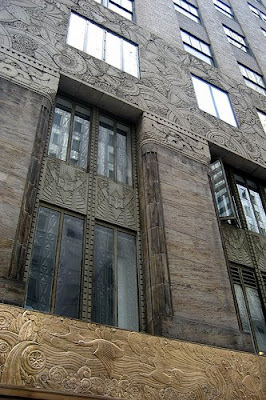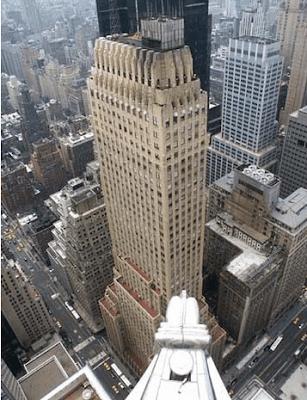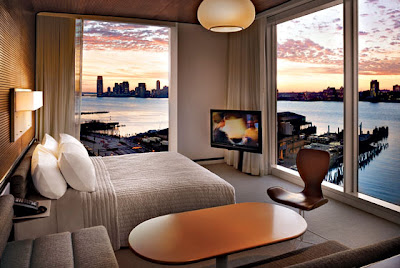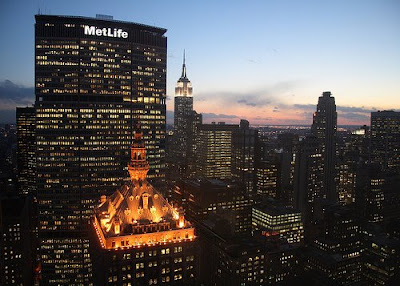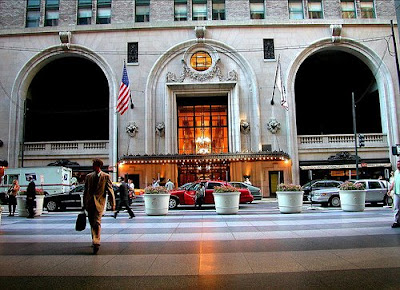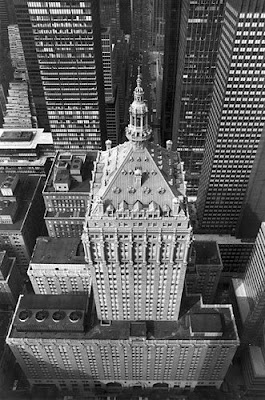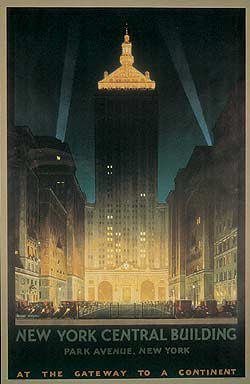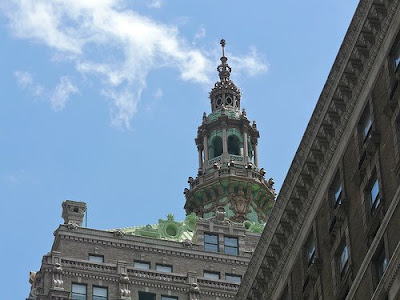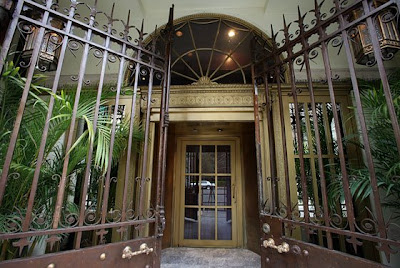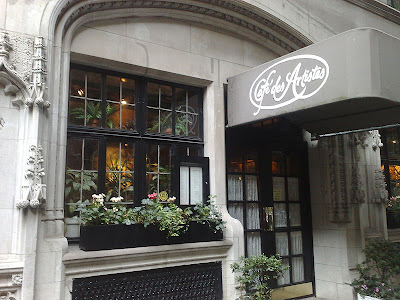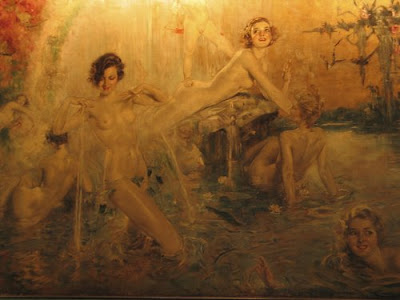87 East 42nd Street at Park Avenue
midway between the Chrysler Building and the New York Public LibraryClosed for fours hours each day (from 1:30-5:30 am).

The four-sided clock atop the low, round Information Booth in the middle of the main hall gives the best viewpoint to see most everything on the Main Concourse. A world-famous rendezvous spot, the circular marble and brass pagoda in the center of the Main Concourse has a hidden, spiral staircase leading to the Information Booth on the Lower Level. During the recent restoration the clock (made by the Seth Thomas Company) was moved slightly to align with the compass points of the building. The clock’s faces are made from opal, and it is said that it would cost millions of dollars to duplicate it today.

As you glance around this vast concourse, you should perhaps first contemplate a bit of the rail history at this location, dating back to 1871.
Click photo to enlarge.
Shipping magnate "Commodore" Cornelius Vanderbilt purchased property between 42nd and 48th Streets, Lexington and Madison Avenue for construction of a train depot and rail yard. On this site was the first Grand Central. This depot, designed by architect John B. Snook, was built at a cost of $6.4 million and opened in October 1871. Virtually obsolete on the day it opened, it was grandly reworked and reborn as "Grand Central Station." The reconfigured depot’s most prominent feature was its enormous train shed constructed of glass and steel. The 100-foot wide by 650-foot long structure rivaled the Eiffel Tower and Crystal Palace as the most dramatic engineering achievement of the 19th century. The updated station also featured a neo-classical façade, a 16,000 square foot waiting room and distinctive ornamentation, including monumental cast-iron eagles with wingspans of 13-feet (one of which was recently salvaged and will rise again above Grand Central Terminal’s new entrance at 43rd Street and Lexington Avenue – the other one can be found on the corner of 42nd Street and Vanderbilt Avenue).
With the demise of steam locomotives (which needed an open-air rail yard), the tracks could be moved underground to accommodate electric trains. By 1902 plans were in place to demolish the existing station and create a new double level terminal for electric trains. Excavation, which began in 1903, was an enormous undertaking, as the grade of the rail yard was lowered to an average depth of 30 feet below street level. The old rail yards were paved over all the way north to 49th Street. A stunning new Grand Central Terminal debuted in 1913, after ten years of construction at a cost of $80 million – roughly $2 billion in today’s dollars. At its heydey in 1947, over 65 million people – the equivalent of 40% of the population of the United States – traveled the rails via Grand Central Terminal. From the 1950s, however, Grand Central entered decades of decline, as the automobile replaced trains as the public’s main means of transportation.

In 1967, New York City's recently established Landmarks Preservation Commission (formed in response to the demolition of Pennsylvania Station) designated Grand Central Terminal a landmark, subject to the protection of law – blocking its planned demolition and redevelopment. Jacqueline Kennedy Onassis was an outspoken advocate against the demolition and redevelopment of the site. In 1976, the National Register of Historic Places named Grand Central Terminal a National Historic Landmark. During the 1980s plans were made to update and restore the landmark structure. This restoration, costing hundreds of millions of dollars, began in 1992. A gala Rededication Celebration of Grand Central Terminal took place on October 1, 1998.
The stunning result of this structural and architectural refurbishment stands before you. Completely restored to its original 1913 splendor, Grand Central has become a midtown destination for five restaurants and cocktail lounges, 20 casual international eateries in the lower level Dining Concourse, gourmet foods from the Grand Central Market and the 50 specialty shops throughout the concourses, all in to addition to its main function as a commuter train transportation hub (67 tracks served by 44 platforms, the largest train station in the world by number of tracks). Grand Central is also a major subway station (second busiest in the system). First, pick up a Grand Central Map and Directory at the "I LOVE NEW YORK" information window in the Main Concourse.
The Beaux Arts interior of the Main Concourse measures 275 feet long by 120 feet wide, and the vaulted ceiling is 125 feet high. The arch windows are 60 feet high at each end. The floors are paved with Tennessee marble, and the walls are covered with buff colored stone with wainscots and trimmings of cream-colored Botticino marble.

The most notable feature of the Main Concourse is the great astronomical mural, from a design by the French painter Paul Helleu, painted in gold leaf on cerulean blue oil. Arching over the 80,000 square-foot Main Concourse, this extraordinary painting portrays the Mediterranean sky with October-to-March zodiac and 2,500 stars. The 60 largest stars mark the constellations and are illuminated with fiber optics, but used to be lit with 40 watt light bulbs that workers changed regularly by climbing above the ceiling and pulling the light bulbs out from above. Soon after the Terminal opened, it was noted that the section of the zodiac depicted by the mural was backwards. For several decades lively controversy raged over why this was so. Some of the explanations offered were that it just looked better, or it didn’t fit into the ceiling any other way. The actual reason is that Paul Helleu took his inspiration from a medieval manuscript, published in an era when painters and cartographers depicted the heavens as they would have been seen from outside the celestial sphere.
In the original 1913 architectural plans there were supposed to be two grand staircases. In true Beaux-arts style, they were to be balanced, but with a few small differences. But when Grand Central was opened on February 2, 1913 there was only one staircase. The team of architects – St. Paul based Reed & Stem and New York’s Warren & Wetmore – somehow decided against constructing the planned second staircase. During the recent $200 million restoration the second staircase was finally built. Just in case you are wondering, the staircase on the west side of the building by Michael Jordan’s Steakhouse is the original staircase and the staircase leading to Métrazur on the east side of the building is new. The Eastern balustrades are slightly less elaborate to differentiate the old from the new. Both sets of marble steps, sweeping from the Main Concourse up to the mezzanine level, are modeled after the grand staircase of the Paris Opera House (Palais Garnier).

There are melon shaped chandeliers on both sides of the Main Concourse and several more in Vanderbilt Hall. They were always thought to have been bronze, but they had been covered with dirt for many years. The chandeliers were taken down and cleaned recently. Remarkably, with just one cleaning the glistening gold was revealed. Note the bare light bulbs. In 1913 electricity was new and not widely used by normal households, so the New York Central Railroad wanted to give the sense of grandeur, luxury, and opulence to its train terminal, and did this by showing off the nickel and gold- plated chandeliers with electric light bulbs.
As you walk around the building, notice the design in the stonework of the water fountains, above the entrance to the railroad tracks, in the design of the chandeliers, and in the green metal windows frames seen from the Main Concourse and Vanderbilt Hall – Grand Central is filled with acorns and oak leaves. Commodore Cornelius Vanderbilt had a rags to riches story. He did not come from a rich family and therefore did not have a family crest as many wealthy families of the 18th century did. As Vanderbilt’s fortune grew, so did his desire for a family crest. He chose the mighty oak tree’s acorns and oak leaves, referring to the old saying “from an acorn a mighty oak shall grow!”

Two ramps lead down to the lower level, joining in front of the famous
Oyster Bar (closed Sundays), which has been open for all of the Terminal’s history, in continuous operation since 1913. These ramps were hidden for almost 70 years. Back in 1927, the New York Central Railroad, the operating company at that time, decided that they needed more office space, so they built an eight-foot wooden ceiling over the ramps. This made the ramps dark, narrow, and gave a tunnel-like feeling as you walked down to the Lower Level train tracks. These ramps were opened up and brought back to their original splendor.
 Photo at right:
Photo at right:On the balcony level the former private office and salon of 1920s tycoon, John W. Campbell has been refashioned as
The Campbell Apartment, fully restored to its original splendor – and reborn as a cocktail lounge that has been cited in the national media as one of "the best bars in America" (open daily from 3:00 pm). Proper attire is required (no baseball caps, t-shirts, athletic shoes, etc.). If for no other reason, you should visit Grand Central Terminal to have a drink at this lounge.
Note: The Campbell Apartment is frequently rented out for private events, so be sure to call before you stop by. 212-953-0409.The
Whispering Gallery, located at the end of both Oyster Bar Ramps when heading down to the Lower Level, is one of the bigger attractions in the Terminal and offers a phonic treat. Get two volunteers and put them in opposite corners facing the walls. A person can whisper into one of its corners and be distinctly heard diagonally across the gallery on the other side.
The
Biltmore Room, known as the “Kissing Room,” was located right under the old famous Biltmore Hotel (now the Bank of America building) and was where the famous 20th Century Limited train arrived. Celebrities, politicians, and soldiers would get off the trains to meet their loved ones and hug and kiss in the middle of the room before going up stairs into the Biltmore Hotel.
Walk outside the building to see the sculpture
“Transportation” by French artist Jules-Alexis Coutan that sits atop Grand Central Terminal's south facade. You will see Mercury flanked by Minerva and Hercules. Minerva is the goddess of wisdom and represents all the thought and planning put into this building. Mercury is the god of speed and represents both the speed of commerce as it grew up into midtown Manhattan from the financial district and, of course, the speed of trains. The mythological hero, Hercules, represents the strength of the men who built Grand Central. Carved out of Indiana limestone, the group stands 50 feet high and 60 feet wide, weighs 1,500 tons, and surmounts a clock 13 feet in diameter. This clock contains the world's largest example of Tiffany glass.
 Trivia:
Trivia:
During the 1930s, a secret platform, number 61, was constructed under the station. This was built to convey President Franklin D. Roosevelt and his limousine directly into the Waldorf-Astoria Hotel, in order to hide from the public and press his disability, caused by polio.
The Seth Thomas clock company, manufacturer of the valuable four-faced clock atop the center kiosk of the Grand Concourse, went into receivership in January of 2009. The company was founded in 1813, exactly 100 years before Grand Central Terminal opened its doors. The company web site states that there is a new owner, and to revisit the site at a future time for further information.
 LINCOLN CENTER: CELEBRATING 50 YEARS
LINCOLN CENTER: CELEBRATING 50 YEARS







